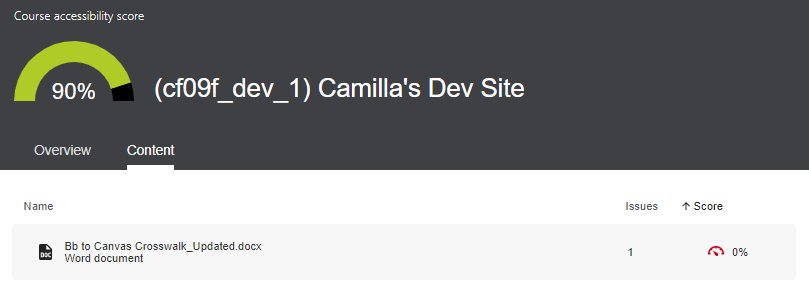| If your accessibility score is lower than you were expecting, don't panic! Remember: Increasing accessibility is a process - you don't have to reach perfection overnight. Incremental improvements are helpful and will help you to achieve greater accessibility in your courses. |
Overview tab
The Overview tab contains a dashboard to visually display all the types of content that you have in your course, content items that will be the easiest and fastest to fix, and items that received the lowest accessibility scores. The Dashboard includes:
- Overall course accessibility score.
- List of all content with accessibility issues.
- All scanned content in your course grouped by content type. Select Start to go to the Content tab and start fixing issues.
- Identification of the easiest issues to fix in the course.
- Identification of the most severe issues in the course.
- List of all scanned items, sorted in order of most severe to least severe.
| Below this dashboard is the list of remaining accessibility issues in your course. If this looks like a long list, don't worry; Ally will help you to decide where to start so that making improvements will be less overwhelming. |

All Course Content Graph
The All Course Content graph groups your course content together by type to show visually which types of content you have and how much of each type of content is present in your course.
Ally checks Files that are uploaded into your Canvas course:
- PDF. See Ally's PDF checklist for more information about specific criteria that Ally looks for.
- Office file types. See Ally's Office document checklist for more information about specific criteria that Ally looks for.
- Microsoft Word (.doc, .docx)
- Microsoft PowerPoint (.ppt, .pptx)
- OpenOffice/LibreOffice files
- Uploaded HTML files
- Image files (.jpg, .jpeg, .gif, .png, .bpm, .tiff). See Ally's Image checklist for more information about specific image criteria that Ally looks for.
- YouTube videos embedded in course pages. See Ally's YouTube FAQ for more information about specific criteria Ally is looking for in YouTube videos.

Clicking the black View button will take you to the Content tab, which displays a list of all your course content.
Deciding What to Fix
If you're not sure where to start when it comes to improving the accessibility of your course content, we recommend starting with these quick and easy fixes. Then, once you're comfortable with those fixes try moving on to either the easy fixes listed in your Course Report or the items in your Course Report that need the most attention because their score is low. Which of these options you choose may depend on how comfortable you feel with accessibility best practices and principles. Simply press the black Start button for the option that you want to pursue. On the next page that loads, click on a specific row to launch the instructor feedback panel to fix the issues in that content item.
| If you're feeling overwhelmed and have never worked on remediating your course content before, we strongly recommend starting with our list of quick and easy fixes. This gives you a chance to get comfortable with some of the adjustments that will be helpful and to avoid being overwhelmed while fixing your content. Then, as you feel more and more comfortable with Ally and fixing accessibility issues, progress on to the other easy fixes identified by your Course Report and the lowest-scoring items that likely need more substantial fixes. |

Remaining Issues
Below the overview dashboard you will see a list of remaining accessibility issues in your course content. This essentially groups your course content according to the types of issues present and lists those accessibility issues in order of priority from severe issues to minor issues. To determine the severity and priority of each issue listed, Ally looks at the number of students impacted, frequency with which the issue occurs, and the accessibility score associated with the issue. Ally categorizes accessibility issues into three tiers:
- Severe: These issues require the most attention because they present the greatest risk to accessibility.
- Major: These issues are not severe, but still have significant impact on accessibility, and so require attention.
- Minor: These issues do not present mission-critical accessibility issues, but should be considered in order to improve your accessibility score.
You can simply click on an issue row to view a list of all your course content that exhibits that issue. Then, select a particular content item to launch the instructor feedback panel to fix the issue.
If you want to use this list to start working through accessibility fixes instead of the low-scoring vs. easy fixes approach previously discussed, then it is best to start with the items at the top of this remaining issues list as those have the greatest impact on your course content accessibility.
Content tab
If you wish to see an itemized list of all your course content with the number of accessibility issues and accessibility score for that item, go to the Content tab.

